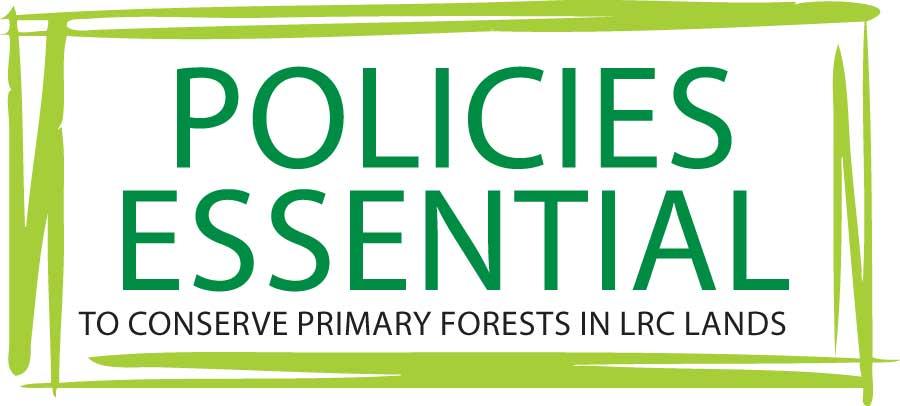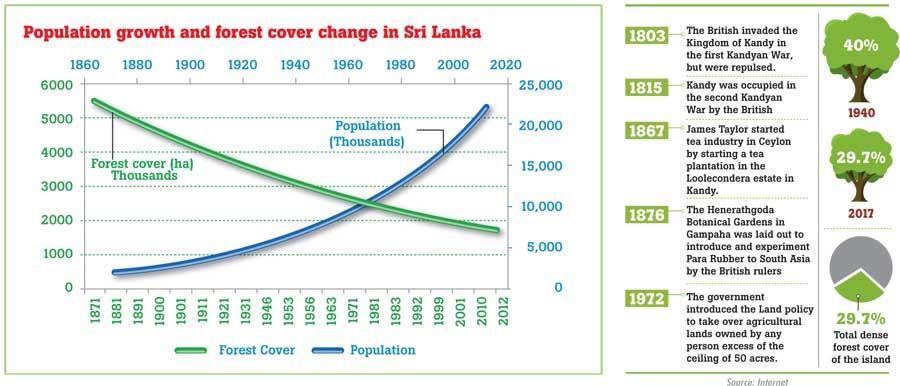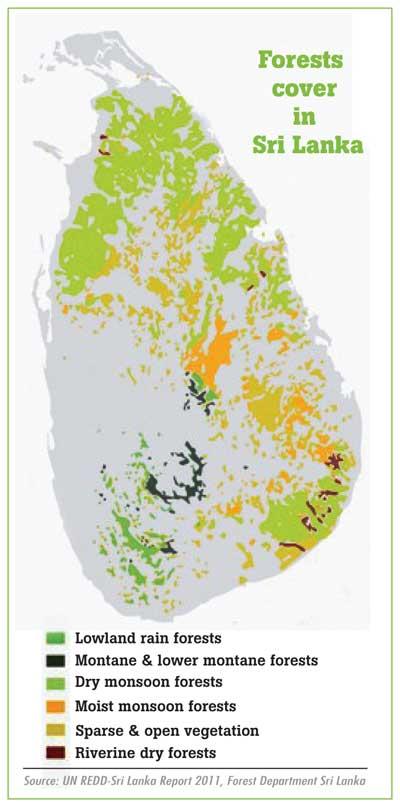Reply To:
Name - Reply Comment

The known truth about deforestation is which had taken place during the British colonial rule to promote export-oriented estates and plantations. Large areas of primary forest land were destroyed in the central highlands to plant popular Ceylon tea and coffee. However, there were restrictions introduced by the British colonial rulers to protect primary forests in the central highlands situated over 5,000 feet above MSL.
Moreover, the rubber plantation was introduced to the midlands as a commercial crop and consequently forest land was cleared to grow rubber. Still, the mountain tops had not been cleared aiming to protect water catchments and climatic disorders.
In 1972, the land policy was drastically changed when the government of that time introduced the Land Reforms law to take over agricultural lands owned by any individual in excess of the ceiling of 50 acres. This resulted in fragmentation of large estates and increase in State-owned property. These also included primary forest lands which the colonial rulers left without clearing to plant commercial crops. Thus, these are not agricultural or bare lands. Such primary forest lands belonging to LRC are precious, environmentally-sensitive areas that need to be protected from environmental and climatic disasters.
In the aftermath of the 1972 LRC law, hundreds of thousands of acres of land that were taken over by the government were distributed among politicians and businessmen in a bid to promote investment. If they were willing to pay the tenure, the lands were released unconditionally by providing deeds of ownership. The tragedy was that some of these properties were not bare or agricultural lands but primary forests. The new land owners started clearing these areas to grow tea and other commercial crops. They also invested in tourist hotels and other commercial activities on these lands to savour disproportionate profits. This was a disaster because such primary forests could not be re-grown.

The Sinharaja rainforest is a UNESCO world heritage site which covers 11,187 hectares. However, there are adjoining primary forest lands on the peripheryof Sinharaja and most of them contain sensitive ecosystems that reflect rich biodiversity. Unfortunately, most of these lands belong to LRC and have already been released to investors thus putting such primary forests  on extreme threat due to large-scale plantations, hotels and other destructive projects. Despite proposals emerging from environmentalists to declare these lands as forest reserves, policymakers deliberately neglect conservation.
on extreme threat due to large-scale plantations, hotels and other destructive projects. Despite proposals emerging from environmentalists to declare these lands as forest reserves, policymakers deliberately neglect conservation.
It is essential to connect these peripheral primary forests with Sinharaja to conserve wet-zone forests and their biodiversity. The situation aggravates by the day due to forest fragmentation. On July 22, 2004, Cabinet decision PS/CS/26/2004 demanded that a recommendation be obtained to arrogate and connect a half-kilometre buffer of LRC lands surrounding the Sinharaja periphery to the world heritage site. Although this recommendation was approved by the Cabinet at that time, relevant institutions had not taken any action to implement it. If the Forest Conservation Department could implement this, more than 2,500 hectares of primary forest lands could be connected to the Sinharaja world heritage site.
The Forest Conservation Department could easily arrogate these primary forest lands and according to the National Environmental Act, the Central Environmental Authority (CEA) has powers to be involved in banning deforestation of primary forest lands of more than one hectare. Moreover, the Environment Minister can declare these lands as protected areas. Sadly, nothing has happened, though there is a government policy to increase forest cover up to 32 per cent. Environmental organisations and activists have continuously demanded that a one-kilometre wide buffer zone (environmentally-sensitive area) be declared surrounding the Sinharaja world heritage site. These efforts ended up futile owing to the high degree of negligence of responsible authorities.
A recent example of deforestation of primary forests in the Sinharaja periphery can be found at Botiyathenna in the Ratnapura District. Handapan Ella and Walankanda primary forest areas located in the Sinharaja forest periphery are under threat. The lands are located over 3,000 feet above MSL and insufficient research has been conducted on the rich biodiversity in these areas. These primary forest areas are LRC lands and large portions of them (50–300 acres per portion) have been distributed among private owners to initiate investment.
Most of the primary forests have been cleared and are still being cleared to plant tea, black pepper and cardamom. Some of the primary forests were cleared and are still being cleared to build large-scale tourist hotels and start bottled-water projects. Granite projects and mining in these forest areas have resulted in soil erosion thereby destroying the whole balance of the ecosystem. Although only a few portions of primary forest lands are remaining, these lands are also under threat of rapid clearance. This is due to their private ownership provided by LRC. It is evident that equipment and machinery such as excavators and compressors are yet parked in these sites and roads have been built to reach mountaintops to expand project sites.
This initiative is not aimed at proposing to ban investment in bare or agricultural lands blindly and uncritically, but to declare primary forest lands belonging to LRC and those which have already been released for investment as reserved, environmentally-sensitive areas.
The government should at least implement Cabinet approval PS/CS/26/2004 to arrogate primary forest lands surrounding the Sinharaja periphery.
(By Dr. Indi Akurugoda, Senior Lecturer, Ruhuna University Public Policy Department and Manjula Karunaratne, Senior Lecturer, Ruhuna University Geography Department.)